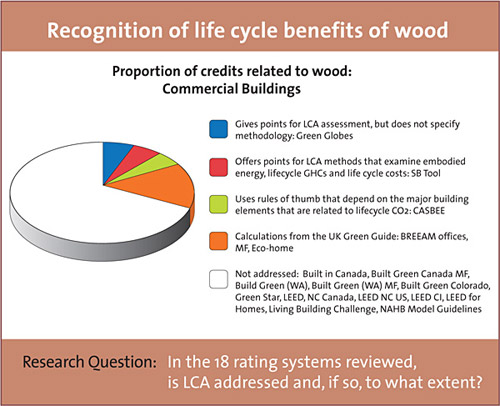Wood Rates: How Wood Products Stack Up in Green Building Systems
There are suites of tools from eco-calculators and impact estimators that enable architects to test, say, a wood exterior wall vs. a wall built of another building material, and to judge their relative environmental merits. "These tools have been around for years and they just keep getting better and better," says Goodland. "The problem is that at this point there is little motivation for uptake due to lack of rating system recognition."
 |
|
Source: Light House Sustainable Building Centre |
What the Future Holds
According to the study, much of the headway in documenting wood as a green building material comes from Europe. Strategies that have gained a foothold in Europe have the potential to push the green building industry to greater environmental achievements - and it is likely only a matter of time until they take hold across the pond. "Europe may be the harbinger of future green building activity in North America," says Goodland. If so, increased attention will be paid to the carbon inputs into a building and the product-related carbon information that is available to designers. Emerging strategies to get to carbon-neutral buildings include:
Life cycle analysis as a separate credit. As tools and methodologies become more rigorous and easy to use and the emphasis increases on carbon disclosure and the relative sustainability quotient of competing products, rating systems may adopt LCA as a separate credit. For an early indication, architects are advised to look at whether and how LEED incorporates credits for LCA, as a result of its current pilot program for LCA points.
More quantitative green information. Manufacturers may become more involved in developing the quantitative information to address criteria necessary to achieve specific credits for wood-based products that have recycled content and/or use low-VOC and low/no added formaldehyde. Easy-to-use design guides, structural sizing charts, code interpretations, credit application "cheat-sheets" may be available to help building professionals negotiate their way through the tangle of rating systems and earn credits for the use of wood in residential and non-residential applications.
Environmental product declarations. Environmental product declarations (EPDs) hold out the promise of disclosure of the environmental performance of products in such a way that the consumer can make side-by-side comparisons of different products, much like a nutrition label does. EPDs are far more prevalent in Europe, particularly Germany, France and the UK than in North America. Yet the move to EPDs is picking up steam here too. One example is the Cascadia Green Building Council's Pharos project which aims to provide not a certification but information on critical health and environmental data about the manufacture, use, and end of life of building materials. "Architects should know to ask for this kind of information and put it on their list when they question a manufacturer about products they are interested in specifying," says Goodland. Though currently a fairly complicated moving target, especially in North America, Trusty predicts that in the near future EPDs will be coming on like gangbusters. "There are almost 500 'green' labels out there," he says. "LCA-based systems and EPDs will start to clear that up."
Salvaged wood and the pine beetle. With the extent of mountain pine beetle damaged forests across North America, the salvaged wood may stand to be admissible under salvaged materials credits or through regional priority credits, particularly as it gains a solid track record in LEED (and Green Globes) certified projects. Alternatively, mountain pine beetle killed wood can be considered a carbon storage strategy through a life cycle carbon evaluation.









